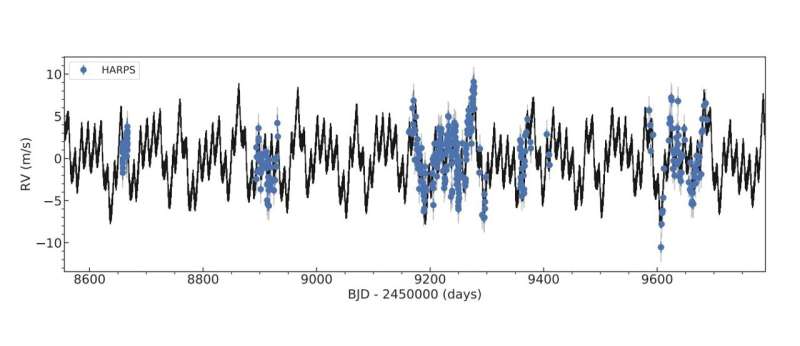By conducting radial velocity (RV) follow-up observations of the GJ 367 planetary system with the High Accuracy Radial velocity Planet Searcher (HARPS), an international team of astronomers has detected two additional alien worlds, at least four times as massive as the Earth. The finding was reported July 18 on the pre-print server arXiv.
Located some 30.7 light years away, GJ 367 (also known as TOI-731 or TIC 34068865) is a bright star of spectral type M1.0 V, nearly half the size and mass of the sun. It hosts an ultra-short-period (USP) sub-Earth exoplanet, GJ 367 b, discovered in 2021. This small extrasolar world, which encircles the host star in less than eight hours, has a radius of approximately 0.72 Earth radii and its mass is estimated to be 0.55 Earth masses.
Now, a group of astronomers led by Elisa Goffo of the University of Turin in Italy, reports that GJ 367 b has two low-mass companions. The discovery is a result of an intensive radial velocity campaign conducted with the HARPS spectrograph, complemented with observations using NASA’s Transiting Exoplanet Survey Satellite (TESS).
“With the aim of improving the planetary mass and radius and unveiling the inner architecture of the system, we performed an intensive radial velocity followup campaign with the HARPS spectrograph—collecting 371 high-precision measurements over a baseline of nearly three years—and combined our Doppler measurements with new TESS observations from sectors 35 and 36,” the researchers wrote in the paper.
The newfound planet closer to the star received designation GJ 367 c. It has a minimum mass of 4.13 Earth masses and its predicted radius is estimated to be 1.6 Earth radii. GJ 367 c orbits the host every 11.5 days.
The outermost planet in the system, GJ 367 d was measured to be at least six times more massive than the Earth. It has an orbital period of approximately 34 days and its predicted radius was calculated to be about 1.7 Earth radii.
The study also refined mass and radius determinations for GJ 367 b. It was found that the planet has a mass of approximately 0.63 Earth masses and its radius is 0.7 Earth radii. These results yield an ultra-high density of 10.2 g/cm3 and suggest an iron core.
Summing up the results, the authors of the paper noted that GJ 367 belongs to the small group of well-characterized multiplanetary systems hosting a USP exoplanet, with GJ 367 b being the densest and smallest ultra-short-period planet known to date. Therefore, further observations of GJ 367 and its planets could help us better understand the formation of such systems.
“This unique multiplanetary system hosting this ultra-high density, USP sub-Earth is an extraordinary target to further investigate the formation and migration scenarios of USP systems,” the astronomers concluded.



